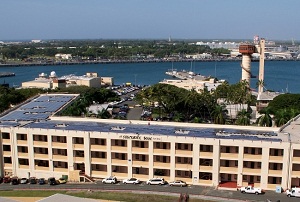Historic Pearl Harbor steps into future with solar
 As part of the U.S. Department of Defense’s plan to increase energy independence and security, it has installed 2.4 megawatts of solar on the roofs of military buildings in the historic Navy base at Pearl Harbor.
As part of the U.S. Department of Defense’s plan to increase energy independence and security, it has installed 2.4 megawatts of solar on the roofs of military buildings in the historic Navy base at Pearl Harbor.
Five roofs at the combined Navy and Air Fore base now known as Joint Base Pearl Harbor-Hickam are covered in more than 1,000 Oregon-based SolarWorld panels. All together, the panels will produce more than 3.4 gigawatt-hours of electricity a year, enough to power 440 average homes, according to a SolarWorld press release.
The $15 million project is part of a defense department campaign to switch all military bases to renewable, sustainable, localized sources, said SolarWorld spokesman Ben Santarris.
“Whenever they have a chance at one of their bases to install renewables, they do it,” Santarris said. “I think there are more and more projects like this, and there will be more and more.”
With 2.4 megawatts of installed rooftop solar, the project at Pearl Harbor is one of the bigger ones for military bases.
The panels are all installed, and there is just a touch of configuration left to complete before they are generating power for the base, Santarris said.
The buildings outfitted with solar include the historic Bachelor Enlisted Quarters structure built in 1927. It survived the bombings at Pearl Harbor in 1941 despite its close proximity to the shipyards.
Other base buildings now clad in solar include the headquarters building, constructed in the 1940s, the Navy Exchange shopping plaza, a commissary building and a large furniture distribution center.
Santarris visited the site over Memorial Day weekend.
“During my visit, the skies were partly cloudy, the sun not yet particularly high in the sky, and the temperature only warm, not hot,” he writes in his blog. “Yet, the light’s intensity was blinding, oppressive. More than at any other solar project I have seen, I had a visceral sense of confronting a technology that was directly harvesting a mother lode of energy.”
The project brings together both our nation’s history and its future, Santarris said. Having solar panels on the roof of these historic buildings, especially ones like the Bachelor quarters that survived the attacks from the Japanese, signifies a new direction, he writes.
The solar installations at Pearl Harbor are significant, he said.
“I count them among a series of iconic solar projects this year that, to me, herald a dawning solar prime time,” Santarris writes.
Image courtesy of SolarWorld.



